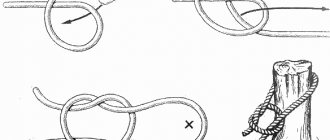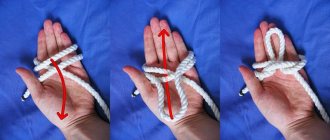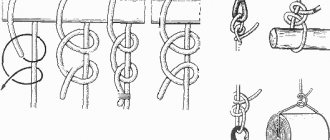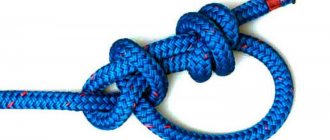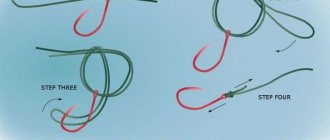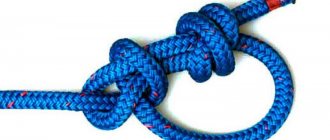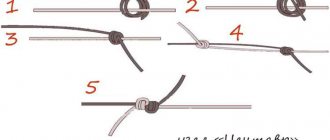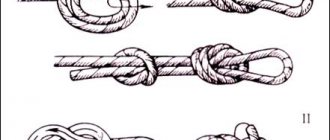Marchard's knot (Austrian)
Marshar Knot
This knot is a descendant of the Prusik knot we already know. It is used for the same purposes - as a grasping knot. At the same time, it grasps faster on the rope than the Prusik knot. It crawls less on wet and icy ropes than the “Prusik” (which does not hold on icy ropes at all), therefore, there is less risk of going into “free flight” in the event of a breakdown with a knot in its hands and sadness in its eyes.
It knits quite quickly and easily. One of the advantages of the Marshar knot is its ability to creep in one direction and grab when loaded on the other side. This is convenient to use for climbs. This knot should be knitted with a thin rope around a thick one; the greater the difference in the diameters of the ropes, the better it will grip. The Marchard knot is used mainly as a safety knot in mountaineering. It can also be used to guide rope crossings and for ascents (instead of a jumar).
Fifteen best sea knots
Page 1 of 4Next ⇒Sea knots
• 15 best sea knots • Knots for thickening a cable • Knots for tying two cables • No-tightening knots • Tightening knots • No-tightening loops • Tightening loops • Quick-release knots
- Simple knot.
- Eight.
- Stevedoring knot.
- Bloody knot.
- Fire escape.
- Multiple eight.
- Oyster knot.
- Deadeye knot.
- Oak knot.
- Flemish knot.
- Water node.
- Babi's knot.
- Mother-in-law's knot.
- Straight knot.
- Thief's knot.
- Surgical node.
- Academic node.
- Flat knot.
- Dagger knot.
- Herbal knot.
- Packet node.
- Fisherman's knot.
- Snake knot.
- Weaving knot.
- Versatile knot.
- Polish knot.
- Clew knot.
- Bramlock knot.
- Docker node.
- Furrier's knot.
- Liana knot.
- Hunting knot.
- A simple half bayonet.
- A simple bayonet.
- Bed bayonet.
- A simple bayonet with a hose.
- A simple bayonet with two hooks.
- Bayonet with carryover.
- Fishing bayonet (anchor knot).
- Reverse bayonet.
- Mast bayonet.
- Port node.
- Towing bayonet.
- Self-tightening knot.
- Self-tightening knot with half bayonet.
- Cow knot.
- Blind loop.
- Clove hitch.
- Retractable bayonet.
- Constrictor.
- Double constrictor.
- Python knot.
- Mining node.
- Picket knot.
- Gaff knot.
- Lisel knot.
- False knot.
- Pike knot.
- Camel knot.
- Stopper knot.
- Swing unit.
- Zigzag knot.
- Finger knot.
- Bitten knot.
- Noose with half bayonets.
- Oak loop.
- Vein loop.
- Flemish loop.
- Honda.
- Eskimo loop.
- A perfect loop.
- Fishing loop.
- Burlatskaya loop.
- Riding loop.
- Grass loop.
- Gazebo node.
- Double gazebo knot.
- Boatswain's knot.
- French top knot.
- Top knot.
- South Cross.
- Running simple knot.
- Sliding eight.
- Sliding blind loop.
- Running bowline.
- Silk knot.
- Scaffold node.
- Tightening noose.
- Drunk knot.
- Shackle knot.
- A simple knot that can be untied.
- Unleashing figure eight.
- An untied running simple knot.
- Reef node.
- Double reef knot.
- Untying weaving knot.
- Kalmyk knot.
- Untied self-tightening knot.
- Boat knot.
- Mill node.
- Wet half bayonet.
- Courier hub.
- Bucket knot.
- Pirate's Knot.
Fifteen best sea knots
Arbor knot or bowline. Non-tightening loop. Suitable for almost all cases of working with cables in marine practice. It is considered the best knot.
Improved Dagger Knot. Designed for connecting two cables.
Flat knot. Designed for connecting two cables. Even steel cables can be tied together.
Flemish knot. Designed for connecting two cables.
Flemish loop. Non-tightening loop.
"Eight". Designed to thicken the cable.
False knot. Designed for attaching a cable to an object.
A simple bayonet with two hooks. Designed for attaching a cable to an object.
Noose. Designed for attaching a cable to an object. Most often to a tree.
Fisherman's bayonet. Anchor knot. Designed for attaching a cable to an object. Most often to the anchor.
A tightening noose. Tightening loop. Designed for attaching a cable to an object.
Stopper knot. Designed to increase the diameter of the cable to prevent slipping out of the block.
Straight knot. Designed for connecting two cables.
Reef node. Quick release knot. Designed for connecting two cables.
Portuguese bowline. Non-tightening double loop. Similar to a simple bowline. It is used in cases where you need to tie two loops at one end.
Knots for thickening the cable
Simple knot
This is the simplest knot known. To tie it, you need to make a half-knot with the running end of the cable at its root end. It can be tied at the end or in the middle of the rope. To do this, the running end of the cable is carried once around its root part and passed into the resulting loop. Depending on how it is tied, a simple knot can be left or right. This is not only the simplest of all knots, but also the smallest in size. When the cable is pulled, it becomes so tight that it is sometimes very difficult to untie it. The Russian folk proverb suits it perfectly: “No big knot, but a tight one.” This knot, like no other, spoils the cable, as it bends it greatly.
Eight
This knot is considered classic. It forms the basis of one and a half dozen other, more complex units for various purposes. In the form in which it is depicted here, this knot in maritime affairs serves as an excellent stopper at the end of the cable so that the latter does not whip out of the pulley of the block. Unlike a simple knot, it does not damage the cable even with strong traction and can always be easily untied. To tie a figure eight, you need to wrap the running end of the cable around the main one and then pass it into the resulting loop, but not immediately, as in a simple knot, but by first bringing it behind you. This knot can be used for rope handles of a wooden bucket or tub, if the rope passes through two holes on the protruding ends of the wooden staves. In this case, having threaded the rope through both holes, the rivets are tied in a figure eight at its ends on the outer sides. Using two figure eights you can securely attach the rope to a children's sled. To prevent your hand from slipping off the end of the dog leash, we recommend tying a figure eight. In addition, it serves well for attaching strings to the pegs of violins, guitars, mandolins, balalaikas and other musical instruments.
Stevedoring knot
Like the figure eight, this knot is a stopper for the cables passing through the pulleys of the blocks. It is knitted in the same way, the only difference being that the running end is inserted into the loop after it has been wrapped around the root end of the cable twice. When tightening this knot, you need to make sure that the hoses at the root end do not twist and slip into the loop. A tight stevedoring knot is easier to untie if you pull the loop that is closer to the root end. The name of this node is of American origin. It first appeared in Webster's English Dictionary in 1890. The compilers of this dictionary borrowed it from a manual on tying knots issued by the American rope company.
Bloody Knot
This knot differs from a simple knot in that its running end, being inserted into the loop, is once again wrapped around the root part of the cable. This almost doubles the size of the node. There are two ways to knit such knots. If the number of knots does not exceed three, the hoses are made with the running end of the cable inside the loop (a.), and if it is more, then around the root part of the cable and its running end is passed inside (b.). Since the ancient times of the sailing fleet, such multiple simple knots were called “bloody” by sailors from different countries. The register of punishments for sailors in naval fleets of the past includes beatings with molts and whips, which were called “cats,” which are forgotten today. They were a lash made of hemp cable, which had from seven to thirteen braids, but more often - nine. Each of the braids ended with a knot, which had from two to ten strands. “Cats” were divided into simple and thieves. The latter were more difficult. They were flogged for theft. Depending on the offense, the sailor could receive from one to twelve dozen as punishment. Usually, after the third blow to the offender’s back, blood appeared, since the knots, tightly tied at the ends of the “cat” braids, cut through the skin (hence the name of the knot). After the first dozen blows, the bloody pigtails of the “cat” stuck together into one bundle and the blows became unbearable, the sailors lost consciousness and died in a state of shock. In order not to lose well-trained sailors in this way in peacetime, the British Admiralty in the middle of the 27th century issued a sanctimonious order: after the first dozen blows, the boatswain’s mate was obliged to untie the “cat” pigtails stuck together from blood. This procedure was called “combing the cat.” The idiomatic expression “To scratch the cat” is still preserved in modern English, which, reminiscent of the barbaric punishment on ships, now has the meaning of “to relieve suffering.”
Fire escape
The fire escape consists of a series of simple knots that are worked very quickly one after another. Knitting this knot begins with the formation of pegs wound behind each other. Take the running end of the cable in your left hand, stepping back 15-20 cm from its edge. Make the first pebble with a diameter of no more than 10 cm so that the root end of the cable is at the bottom. Then make exactly the same pebble and press it with the thumb of your left hand to the tips of the others. In exactly the same way, make 5-7 pegs, evenly laid one on top of the other. To prevent them from moving or getting tangled, put them on the outstretched fingers (except the thumb) of your left hand. You will get a kind of rope “cup”. Carefully remove it from your fingers so that it does not crumble or flatten. Now pass the running end, which you held in your left hand, inside this “cup” onto your left palm and clasp it on all sides with five fingers. With the bent tips of the fingers of your right hand, hold the upper hose of the “cup” and slowly, without jerking, pull the running end of the cable sticking up from the cup. As this running end is pulled out, simple knots will be tied on it. Their number will correspond to the number of pegs made, and the distance between them will correspond to the length of their circumference. In the daily activities of sailors, steeplejacks, builders, firefighters, mountain rescuers and rock climbers, there is often a need to use a so-called pendant with musings. In the navy, a pendant is a vertically hanging rope attached to something with its upper part, and musings are thickenings on it, woven into it in the form of knots, at regular intervals. But a manufactured pendant with musings is not always at hand. In such a situation, the “fire escape” comes to the rescue.
Multiple eight
Imagine that you need to tie a rope around a large cardboard box, a bale, or an old suitcase. Having done this, you discovered that one and a half meters of rope remained unused. By tying the running end of the rope around the part by which you will carry this load, using a repeated figure of eight, you will not only shorten the rope, but also make a comfortable handle for this load. To make the knot even and tight, as you tie it, tighten each hose, moving it towards the previous one. If you later need to use the entire length of the rope, multiple figure eights are easy to untie. No matter how tightly it is tightened, it will not damage the rope. The knot can be used in all cases when there is a need to temporarily shorten the cable or exclude an unreliable part of its length from operation if there is a fear that it will break. A multiple figure of eight is a good handle for both a dog leash and a children's sled.
Oyster knot
This knot has one peculiarity of tying: it is tightened in two steps (a.). First, tie a running simple knot and tighten it. Having passed the running end of the cable into the loop, tighten the knot again. If the oyster knot is tightened in one step, it will not form correctly. Diagram (b) shows a pattern of an oyster knot, indicating its symmetry. In this form, it can serve as a good decorative ornamental knot for finishing a woman’s dress or as a pattern for embroidery. Despite its name, this knot, like the figure eight, due to its symmetry, is successfully used by musicians for attaching the strings of a violin, guitar, mandolin and other musical instruments to pegs. The size of a tightened oyster knot is much larger than a figure eight, so it is used in cases where the holes on the pegs are, for some reason, larger than needed for a particular string.
Deadeye knot
The diagram shows two ways to knit it. The first method (a.), based on a simple knot, involves inserting the running end into the loop from below between the main and running ends and then passing it under you. The second method of tying a deadeye knot (b.) involves tying a figure eight and pulling both ends into its corresponding loops, as shown by two arrows. In the days of the sailing fleet, this ancient sea knot was used to tension the shrouds using cable lanyards and deadeyes. It was tied at the end of the lanyard in order to hold the latter in the hole of the deadeye.
Oak knot
Sailors use it only in exceptional cases, when there is a need to very quickly tie two cables together. Although connecting plant cables with an oak knot is quite reliable, it has a serious drawback: a tightly tightened knot is very difficult to untie later, especially if it gets wet. In addition, a cable tied in such a knot has less strength and during operation creates a danger of catching on something during its movement. Its only positive qualities are the speed with which it can be tied and its reliability. To connect two cables, their ends need to be folded lengthwise together and, stepping back 15-20 centimeters from the edges, tie both ends as one whole with a simple knot. Do not try to tie synthetic cables and fishing line with this knot: it crawls on them.
Flemish knot
This is one of the oldest maritime knots, which was used on ships to connect two cables, both thin and thick. In fact, this is the same figure eight, tied at both ends. There are two ways to tie this knot. First, make a figure eight at the end of one of the cables tied together. Towards the exit of the running end, insert the running end of the second cable and repeat figure 8, tied on the first cable. After this, grab each two ends, left and right, and begin to tighten the knot evenly, trying to maintain its shape. To final tighten the knot, pull the root ends of the cables (see figure). To connect two cables with a Flemish knot using the second method, place the running ends of the cables being connected parallel to each other so that they touch each other approximately along the length of one meter. At this point, tie a figure eight with two cables folded together. In this case, you will have to carry it around and thread it into the loop along with the short running end of one of the cables and the long main one. This is precisely the inconvenience of the second method of tying the Flemish knot. The connection of two cables with a Flemish knot is considered very strong. This knot, even if tightly tightened, does not damage the cable, and it is relatively easy to untie. In addition, it has excellent quality - it does not slip and holds securely on synthetic fishing line.
Water node
The connection of two cables with a water knot is considered no less strong. To tie it, place the ropes to be tied with their ends facing each other so that their ends run parallel and touch each other. Holding the running and root ends of two different cables in one hand, begin to knit an oak knot with them, but instead of one run-out of the root end, make two. Before finally tightening the knot, make sure that one pair of ends comes out of the loop from the top, and the second from the bottom, as shown in the diagram. The water unit is simple and reliable. It has not found wide use in the navy, because with strong draft it becomes so tight that it is very difficult to untie it.
Babi knot
How much irony and disdain can be heard from sailors towards this primitive and, unfortunately, unit that has firmly taken root in our everyday life. This is exactly what sailors should not do - tie this knot. A naval man who unluckily tied a woman's knot even on shore will certainly be ridiculed by his colleagues. Like, this is a disgrace for the fleet. But, alas, among land people this knot is a universal one. The vast majority of people who are not familiar with rigging, or those who, by their profession, do not deal with ropes, ropes, or threads, use the woman’s knot in all cases when they need to tie, tie or tie something . It seems that people, having learned this knot in childhood, believed so strongly in its utilitarian nature that they don’t even want to hear about any other complex sea knots. Nevertheless, speaking seriously, this traitorous knot has caused a lot of troubles throughout the history of mankind and even claimed many human lives. The Babi knot consists of two half-knots tied sequentially one above the other in the same direction. If you tie two ropes with it and pull it, you can immediately see that it begins to move along the rope and slide along it. And if it is tied close to one of the tied ends of the rope, then when pulled, it can slip and will certainly slip if the tied ropes are of different thicknesses. Unfortunately, not everyone knows about this and continues to use it. In our country, this knot got its name due to the fact that from time immemorial women tied the ends of their headscarves with it. Abroad, it is called the “grandmother’s”, “stupid”, “veal”, “false”, “newborn” knot. But, oddly enough, sailors and fishermen of some countries use the woman’s knot in their work. In addition to its negative qualities (sliding and not being untied), they caught one of its positive properties - under certain conditions, it can instantly turn into a simple bayonet - one of the simplest and most reliable sea knots for securing the mooring of a vessel on the shore with a pole, bollard or mooring bollard . But in order to tie a simple bayonet when mooring, you need to get off the ship ashore and do it directly at the fireplace or bring the end to the shore so that those standing on the shore can do it. But it turns out that a simple bayonet can be tied to the mooring bollard without leaving the ship ashore. And this is done with the help of a woman’s knot, despised by sailors... To do this, at the end of the cable, which they intend to bring ashore for fastening it with a simple bayonet around the pole, a loop is made, the running end of which is connected to the root end with a woman’s knot, which is not fully tightened. From the side of the ship this loop is thrown onto the pole. When tugging at the main part of the mooring line, the woman's knot turns into a simple bayonet.
Mother-in-law's knot
Some people, when tying two ropes together, somehow manage to tie a so-called “mother-in-law” knot, which is somewhat reminiscent of a woman’s knot. If in the latter the running ends come out of the knot on one side, then in the mother-in-law knot they come out from different sides diagonally. The “mother-in-law’s” knot is just as insidious as the woman’s (if not more). It should not be used under any circumstances.
Straight knot
Archaeological finds indicate that the Egyptians used it approximately three thousand years BC. The ancient Greeks and Romans called it Nodus Hercules - the Hercules or Hercules knot, because the mythical hero Hercules tied the skin of the lion he killed on his chest with it. The Romans used the straight knot to stitch wounds and heal broken bones. It consists of two half-knots, sequentially tied one on top of the other in different directions. This is the usual easiest way to knit it (Fig. a). Sailors, who have been using this knot since ancient times to tie cables, use a different tying method (Fig.b). Weavers who use a straight knot to tie up broken threads of yarn tie it in their own, special way, convenient for them (Fig. c). When there are large loads on the connected cables, as well as when the cables get wet, the straight knot is greatly tightened. How do you untie a straight (reef) knot, which is so tight that it cannot be untied and will have to be cut. A straight knot, even if wet and tightly tightened, can be untied very simply, in 1 - 2 seconds. Tie a straight knot as shown in diagram (d). Take ends A and B in your left hand, and ends C and D in your right hand. Pull them strongly in different directions and tighten the knot as tightly as possible. After this, take the root end of A in your left hand (to prevent it from slipping out of your hand, make a couple of slings around your palm). Take running end B in your right hand (it can also be wound around your palm.). Pull the ends sharply and firmly in different directions. Without releasing end A from your left hand, clench the remaining part of the knot into your fist with your right hand, holding it with your thumb and forefinger. Pull the root end A to the left - the knot is untied. The whole secret is that when ends A and B are pulled in different directions, the straight knot turns into two half-bayonets and completely loses all its properties. It also comes undone easily if you take the root end G in your right hand and pull the running end B strongly to the left. Only in this case, the end of G must then be pulled to the right, and the remaining part of the knot (half bayonets) - to the left. When untying a straight knot in this way, remember that if you pulled the running end to the right, pull the main end to the left and vice versa. When untying a straight knot, one should not forget that with the same force it was tightened, one of its running ends must be pulled with the same force.
Thief's Knot
At first glance, it is almost no different from a straight knot and it seems that it is akin to it. But if you look closely, it becomes clear that the running ends of the thief's knot come out of it diagonally. The thief's knot, like the woman's and mother-in-law's knots, are shown for clarity in order to emphasize their similarities and differences with the straight knot. It is not recommended to use these four knots, as they are unreliable for connecting two cables. The origin of the name “thief's knot” is curious. It appeared on English warships at the beginning of the 17th century. The theft of royal property and the theft of personal belongings of sailors on British ships were considered commonplace. In those years, sailors on warships stored their simple belongings and food, mainly in the form of biscuits, in small canvas bags. Naturally, the bag cannot be locked, it can only be tied. As a rule, sailors tied their personal bags with a straight knot. The thieves, mostly recruits who were not yet accustomed to the starvation ship rations, having stolen other people's biscuits, could not correctly tie the knot with which the bag was tied. They knitted something similar - a knot that the sailors began to call a thief's knot. There is a second version about the origin of this name: to prove the act of theft from a bag, the owner deliberately tied a knot very similar to a straight one, and the thief, not paying attention to the catch, tied the robbed bag with a straight knot. But be that as it may, the origin of the node itself, like its name, is connected with the Fleet.
Surgical knot
They are still used by surgeons to tie ligature threads to stop bleeding and to stitch tissue and skin. Nowadays, medicine has not yet abandoned the use of nodes, and doctors skillfully use them. During abdominal operations, surgeons have to apply sutures made of catgut (a special material obtained from the mucous layer of the intestines of a ram or sheep), which resolves after 3-4 weeks. When tying, the catgut slips, and when making knots on it, surgeons use special clamps. During microsurgical operations, doctors use extremely thin suture material - a synthetic thread 10-200 times thinner than a human hair. Such a thread can only be tied using special clamps under an operating microscope. These threads are used when stitching the walls of blood vessels, for example, when replanting fingers, or when stitching individual nerve fibers. They mainly use woman's, straight, bleached, surgical knots and the so-called “constrictor” knot. When tying a surgical knot, first make two half-knots one after the other with two ends, which are then pulled in different directions. Then another half-knot is tied on top, but in the other direction. The result is a knot very similar to a straight one. The principle of the knot is that the first two half-knots prevent the two ends from moving apart while another half-knot is knitted on top. This knot is convenient to use when there is a need to tighten and tie some elastic bale or burden with a rope and the tightened first half of the knot on the rope, without letting go of its ends, has to be pressed with your knee.
Academic node
It is very similar to a surgical knot, differing only in that instead of one second half-knot, it has two of them. It differs from its, so to speak, progenitor - the direct knot - in that the running end of the cable is wrapped around the running end of another cable twice, after which the running ends are led towards each other and wrapped around them twice again. In other words, there are two half-knots below and two half-knots on top, but tied in the opposite direction. This gives it the advantage that when there is a heavy load on the cable, it is not as tight as a straight knot and is easier to untie in the usual way.
Flat knot
It has long been considered one of the most reliable knots for tying cables of different thicknesses. They even tied anchor hemp ropes and mooring lines. Having eight weaves, the flat knot never gets too tight, does not creep or spoil the cable, since it does not have sharp bends, and the load on the cables is distributed evenly over the knot. After removing the load on the cable, this knot is easy to untie. The principle of a flat knot lies in its shape: it is really flat, and this makes it possible to select the cables connected with it on the drums of capstans and windlass, on the welps of which its shape does not interfere with the even placement of subsequent hoses. In maritime practice, there are two options for tying this knot: a loose knot with its free running ends tacked to the main or half-bayonets at their ends (a) and without such a tack when the knot is tightened (b). A flat knot tied in the first way (in this form it is called a Josephine knot) on two cables of different thicknesses almost does not change its shape even with very high traction and is easily untied when the load is removed. The second tying method is used for tying thinner cables than anchor and mooring ropes, and of the same or almost the same thickness. In this case, it is recommended to first tighten the tied flat knot by hand so that it does not twist during a sharp pull. After this, when a load is applied to the connected cable, the knot creeps and twists for some time, but when it stops, it holds firmly. It unties without much effort by shifting the loops covering the root ends. As already mentioned, a flat knot has eight intersections of cables and it would seem that it can be tied in different ways; there are 256 different options for tying it. But practice shows that not every knot from this number, tied according to the principle of a flat knot (alternating intersection of opposite ends with under and over), will hold securely. Ninety percent of them are unreliable, and some are even dangerous for tying ropes designed for strong traction. Its principle depends on changing the sequence of intersection of connected cables in a flat knot, and it is enough to change this order a little, and the knot acquires other negative qualities. Before using this knot in practice for any important task, you must first remember its diagram exactly and connect the cables exactly according to it without any, even the most insignificant deviations. Only in this case will the flat knot serve you faithfully and not let you down. This marine knot is indispensable for tying two cables (even steel ones, on which significant force will be applied, for example, when pulling out a heavy truck stuck in the mud half a wheel with a tractor).
Dagger knot
In foreign rigging practice, this knot is considered one of the best knots for connecting two large diameter cables. It is not very complex in its design and is quite compact when tightened. It is most convenient to tie it if you first lay the running end of the cable in the form of a figure 8 on top of the main one. After this, thread the extended running end of the second cable into the loops, pass it under the middle intersection of the figure eight and bring it above the second intersection of the first cable. Next, the running end of the second cable must be passed under the root end of the first cable and inserted into the figure eight loop, as the arrow indicates. When the knot is tightened, the two running ends of both cables stick out in different directions. The dagger knot is easy to untie if you loosen one of the outer loops.
Herbal knot
Despite its name, this elementary unit is quite reliable and can experience heavy loads. In addition, it can be easily untied in the absence of traction. The principle of the knot is half bayonets with other ends (a). Sometimes we have to tie two belts: or two ribbons, well, let's say, reins. For this purpose, the “grass” knot is very convenient (b). It can be tied by slightly changing the “mother-in-law” knot or starting with half bayonets, as shown in diagram (a). When you tighten the “grass” knot by the root ends, the knot twists and takes on a different shape. When it is completely tightened, the two running ends point in the same direction.
Packet node
Its name suggests that it is convenient for tying bags and bundles. It is simple, original and designed for quick knitting. The packet knot is somewhat reminiscent of the grass knot. In terms of strength, it is not inferior to the latter.
Fisherman's knot
In Russia, this node has long had three names - forest, fishing and English. In England it is called English, in America - river or waterway junction. It is a combination of two simple knots tied with the running ends around the alien root ends. To tie two cables with a fisherman's knot, you need to put them towards each other and make a simple knot with one end, and pass the other end through its loop and around the root end of the other cable and also tie a simple knot. Then you need to move both loops towards each other so that they come together and tighten the knot. The fisherman's knot, despite its simplicity, can be safely used to tie two cables of approximately the same thickness. With a strong pull, it is tightened so tightly that it is practically impossible to untie it. It is widely used by fishermen for tying fishing line (not synthetic) and for attaching leashes to fishing line.
Snake knot
This knot is considered one of the most reliable knots for tying synthetic fishing gear. It has quite a lot of weave, is symmetrical and relatively compact when tightened. With a certain skill, you can even tie the strings of a piano with it. To do this, the place where the string is tied must be thoroughly degreased and coated with shellac. The snake knot can be successfully used to tie two cables made of any materials when a strong, reliable connection is required.
weaving knot
In weaving, there are about two dozen original knots for tying up broken threads of yarn and for connecting new spools. The main requirements imposed by the specifics of production on each weaving knot are the speed with which it can be tied, and the compactness of the knot, ensuring the free passage of the thread through the machine. Experienced weavers are truly virtuosos at knitting their ingenious knots. They tie up a broken thread in just a second. They have to do this without stopping the machine. Almost all weaving knots are designed primarily for instant tying, so that in the event of a thread breakage, uninterrupted operation of the weaving machines is ensured. Some of the weaving knots are very similar to sea knots, but differ from the latter in the way they are tied. Some weaving knots have long been borrowed by sailors in their original form and serve them reliably. The weaving knot can be called the “brother” of the clew knot. The only difference is in the method of tying it and in the fact that the latter is tied into a krengel or into a sail, while the weaving knot is knitted with two cables. The principle of the weaving knot is considered classic. Truly this is the epitome of reliability and simplicity.
Versatile knot
This knot is similar to a weaving knot in its principle. The only difference is that in a tied knot the running ends point in different directions - this is very important when tying threads of yarn. It is not inferior in either simplicity or strength to a weaving knot and is just as quickly tied. This knot is also famous for the fact that on its basis you can tie the “king of knots” - the bower knot.
Polish knot
It can be recommended for tying thin cables. It is widely used in weaving and is considered a reliable knot.
Clew knot
1Next ⇒
Noose with half bayonets
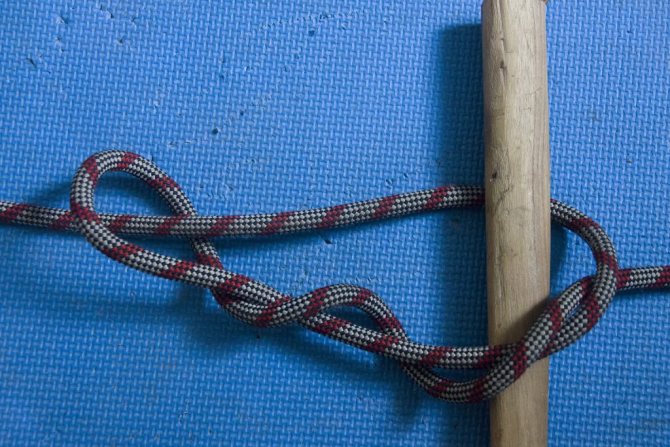
This is a rather interesting and convenient knot that can be used in many life situations. For example, dragging a log or fastening a rope to a tree (this knot should not be used for mountaineering needs). It is this knot that is used to attach the string to the bow and guitar strings. As you might have guessed, the noose only holds when the rope is under tension. When the load is removed, the knot is almost completely untied. When tying and tightening a noose, it is important that the rope does not break through the loop, otherwise its strength will greatly decrease (we remember that the more the rope is bent and compressed, the less its strength at the point of this bend).
As I said, it is not advisable to use this unit for mountaineering and tourism. But, if you need to make an unsafe crossing, where the rope will not experience significant loads and if a person falls, he will not be injured, then you can use a noose. An example would be crossing a small and not deep river or stream, where in case of a breakdown you can only get wet. In the case of such an application, you need to additionally tie a control knot, or even a bayonet. Then the fastening will be safe and rigid, and it will be easy to remove the crossing.
Weaving
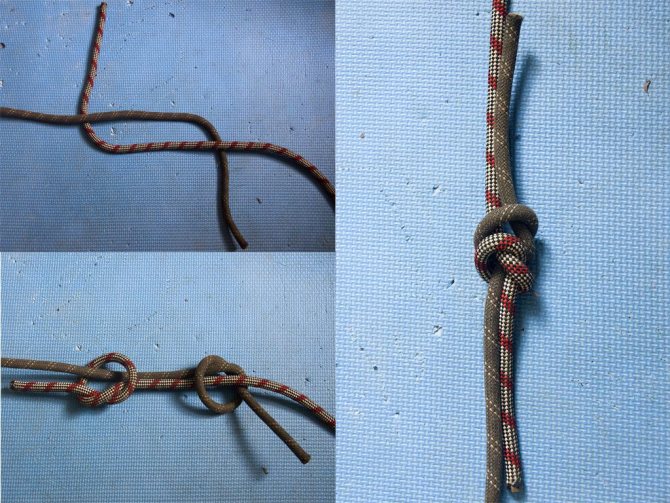
This knot is a fairly simple way to tie ropes of the same diameter. In addition, after tightening it, the assembly itself becomes quite compact. In essence, a weaving knot is just two “controls”. By the way, after tying it, control knots are required on both ropes.
The advantages of the weaving knot: compactness, fast tying and relative reliability of the connection. Disadvantages: very strong tightening (to the point of being impossible to untie), weakening of the rope and the need to tie control knots.
This knot is good for connecting two threads for sewing (the knot is compact), but it is bad for mountaineering and tourism.
Currently, the system of professional training for firefighters involves the study of four knots for securing a rescue rope to a structure, one knot for lifting equipment to a height, as well as a method for rescuing a victim from a height (“double rescue”).
However, a carabiner, a rescue rope and a descender add up to much more!
Disputes between domestic rescuers (“historical people from mountaineering”) and firefighters (“having only 4 fire units”) about whether mountaineering is needed in the fire department, and what units every firefighter must know, will not subside, perhaps, for a long time.
There is also a difference in the approaches between industrial (and rescue) mountaineering with its multiple safety margin and ARISP, where to save the life of a firefighting participant you need a minimum number of knots, one rope and brute physical strength - more in conditions of the active phase of the fire and, often, zero visibility, there is no need to count.
In this article we will not discuss why mountaineering bypassed the fire department. And let’s also not ask the question why, during the interaction, the rescuers did not teach the firefighters the basics of mountaineering.
Most likely, the secret lies in the history of our country, in the history of our development, and everyone must find the answer for themselves.
We suggest you familiarize yourself with several main knots, knitting methods, and also find out the pros and cons of use.
There is nothing complicated in the knots presented below; they have already been published previously on many sites of various types: from mountaineering and “survival in a zombie apocalypse” to “life hacks” and “10 knots that every man should know.”
In order not to “fuel” long-standing disputes, let’s define the terminology and call this list of components not “mandatory for study and use,” but “additional (recommended) for study by every firefighter.”
When compiling our list, we relied on two simple criteria:
- The unit can be used when rescuing participants in fire extinguishing (during an ARISP operation);
- The knot will be strong enough to support the weight of a person.
The list of additional nodes looks quite simple:
- Knot “Middle conductor” (Austrian conductor);
- Grapevine knot (+ control knot or half-grapevine);
- Knot "UIAA" (firefighter's knot);
- Shackle knot;
- Bowline knot (gazebo knot);
- Knot “Simple counter”;
- Knot “Blind loop”;
- Knot “Carbine noose”;
- Knot "Direct Knot";
- Figure Eight Knot (Flemish Loop)
The sequence in which these nodes are studied does not matter. Information on exactly how to knit each of them can be freely found on the Internet, in specialized literature or in applications on a mobile device. You will need patience and a little time. To practice tying methods, you can bring a piece of climbing rope for yourself or for the entire guard, or use a piece of a standard VPS and a regular carabiner.
Knot "Middle conductor" (Austrian conductor)

Application:
Used to organize a loop in the middle of the rope for further load on it on both sides of the knot, to organize attachment points on the rope, to temporarily isolate a damaged section of the rope, when organizing pulleys.
Advantages:
A universal knot: quick to knit, easy to untie after significant loads, works equally well in all three directions, “does not creep” even on a hard, frozen rope.
Flaws:
It is difficult to change the size of the loop once the knot has been tied.
Knitting method:
- Form an open loop on a section of rope.
- Having determined the length of the future conductor, twist the rope twice (rotate 360°), thereby creating two closed loops: one on top of the other.
- Place the top closed loop on the ends of the rope (the bottom loop under the top).
- Pass the top loop into the bottom loop on the reverse side.
- Tighten the knot (you need to stretch the ends of the rope in different directions).
Grapevine Knot

Application:
Used when tying two ropes of the same diameter, for knitting a rope loop.
Advantages:
Reliable node, does not require control nodes.
Flaws:
Once the load is removed, it is difficult to untie, relatively difficult to tie, and requires a large piece of rope.
Knitting method:
- Fold two ropes parallel to each other so that the running ends are directed in different directions.
- With the running end of one of the ropes, make two hoses clockwise around the root end of the other rope and pass it through the turns of the resulting spiral from the side of the root end, tighten.
- Do the same with the running end of the other rope counterclockwise.
- Pull both ropes in different directions until the tightened knots come together completely.
To untie a knot, first pull the knots in different directions, relax and untie one part. After pulling the rope out of the second knot, it is easy to untie it.

A person who has studied this elegant knot will logically come to the control knot (half-Grepwein knot), which also has a wide range of applications.
Knot "UIAA" (firefighter's knot)

Application:
Used to provide dynamic insurance as a braking system. It is recommended for use to ensure the descent of victims and self-descent in the absence of specialized safety and descent devices.
Advantages:
Easy to tie, works both ways (turns over).
Flaws:
Twists the rope (the free end of the rope should come out from the side of the working area of the carabiner).
Knitting method:
- Fasten the rope from bottom to top into the carabiner.
- Make a closed loop on the rope above the carabiner and clip it into the carabiner.
- Lock the carabiner.
Shackle knot (“handcuffs”)

Application:
It is used when tying the limbs of victims for transportation, when fixing the hands of an unconscious victim when lifting him through a narrow hatch or gap. Also, a knot may be necessary when tying up people who are aggressive towards firefighters.
Advantages:
Easy to tie, easy to untie after removing the load.
Flaws:
“Crawling” on a hard, frozen rope
Knitting method:
- Form two closed loops on the rope with the root ends mirrored.
- Place the loops one after the other.
- Pass the formed loops one into another.
- Pull the loops to the desired size.
- Tie a straight knot to fix the size of the loops.
Bowline knot (gazebo)

Application:
It is used to form a loop at the end of a rope for lifting/lowering fire equipment and tools, for insurance when lowering/ascending firefighters and victims, for securing the rope to a structure.
Advantages:
Easy to tie (even with one hand on yourself), easy to untie after loading.
Flaws:
Under variable loads, it “creeps” (unties) and requires a control unit (there is no control unit in the photo!). Long-term use is prohibited; it may weaken.
Knitting method:
- At some distance from the end of the rope, depending on the size of the required loop, make a closed loop with the running end.
- Holding the loop with your thumb and forefinger, you need to pass the running end of the rope into it from the root end.
- The running end of the rope must be wrapped around the root end and returned to the closed loop.
- Grasping the running end with your left hand, pull the root end in the opposite direction.
Knot "Simple counter"
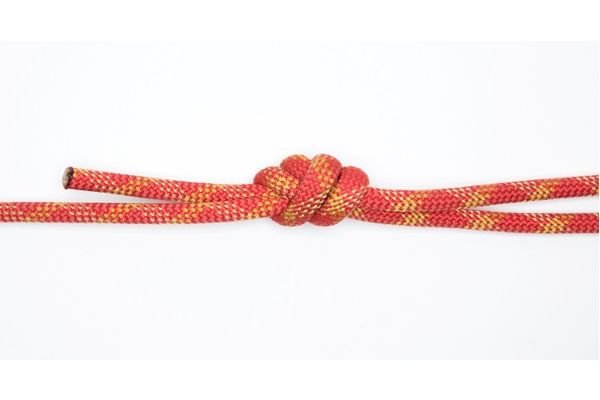
Application:
Used for tying ropes of any diameter, as well as ribbon-rope combinations.
Advantages:
A reliable knot, does not require control knots, the best knot for tying ropes (ribbons).
Flaws:
After removing the load, it is difficult to untie and relatively difficult to knit.
Knitting method:
- Tie a loose, simple knot at one end of the ribbon; it should not twist.
- With the second end of the tape, repeat the knot completely, passing it through the knot, starting from the place where the running end of the tape comes out of the simple knot.
- Tighten the knot evenly (the ends of the tightened knot should extend in different directions and be no shorter than five centimeters).
Blind Loop Knot
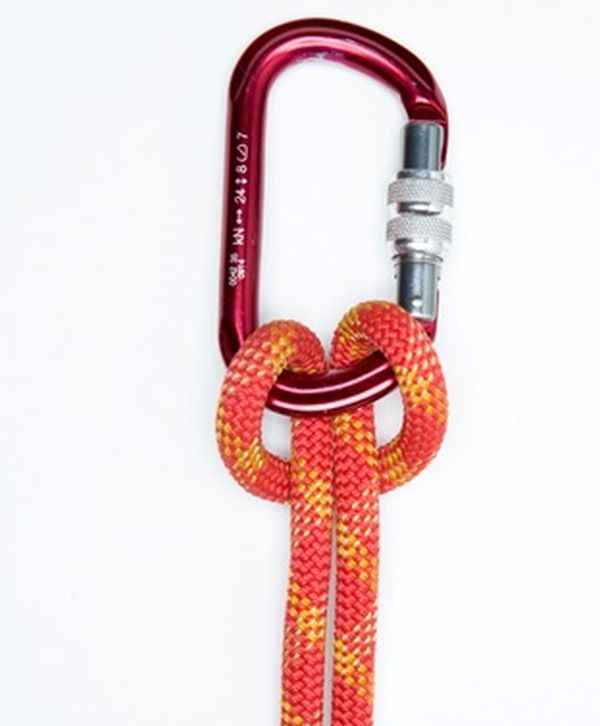
It is a simple tightening knot.
Application:
A blind loop connects a rope or braid to a harness or other rope, strap, or rope. It is also often used for ropes that serve to connect support points to a fixed rope at the top. It is reliable only with constant traction on both ends of a cable or rope. The knot is convenient for tying keys together, for storing washers and other items with a hole.
Knot "Carbine noose"
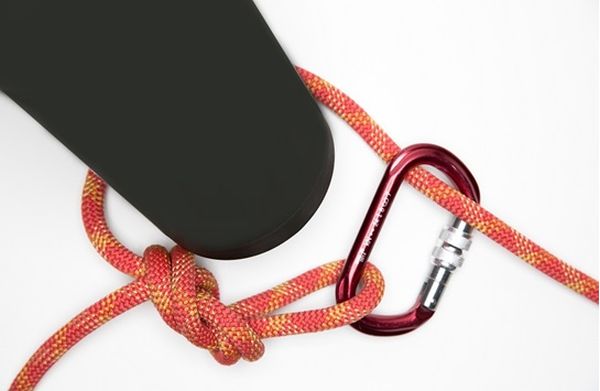
Application:
The knot is used to secure a rope on the terrain, in situations involving subsequent pulling of the rope.
Knitting method:
- A figure eight knot is tied at the working end of the rope.
- A carabiner is attached to it.
- The working end, together with the carabiner, is carried around the structure.
- The carabiner is attached to the root end.
When the root end is loaded, the knot is tightened. If you pull the carabiner using an auxiliary rope, releasing the loaded end, the carabiner will begin to move along the cargo rope, and the cargo rope itself, following the carabiner, will be pulled through.
Direct Knot

Application:
It is used when tying two ropes of the same diameter, for example, VPS-30 when lifting/lowering fire equipment to a height of more than 15 floors.
Advantages:
Easy to knit.
Flaws:
Requires care when knitting, it “creeps”, therefore it requires tying control knots on both sides.

Figure 8 knot (Flemish loop)
Application:
It is used to form a loop on the main rope (belay “mustache”), to tie the rope to a support when organizing belays and self-belays.
Advantages:
It is easily tied both at the end of the rope and in the middle, under load it is tightly tightened, and does not “creep” even on a hard, frozen rope.
Flaws:
Relatively easy to untie, requires care when tying, high consumption of rope.
Knitting method:
- Form an open loop on the rope.
- Use this loop to make an unfinished hose around the running and root ends.
- Pass into the resulting closed double loop.
- When tightening the knot, move the outer loops to the side.

In 1944, the American Clifford W. Ashley published his fundamental work entitled “The Ashley Book of Knots” (ABOK). After 70 years, this book has not lost its relevance, so we invited you to familiarize yourself with ten knots from it.
Knowledgeable people can say that this is not enough, and by giving the fireman only a few knots, we will not improve the situation. But a long journey consists of small steps, and I believe that it is worth stopping arguing and no longer returning to the topic “why some didn’t teach, and why didn’t others take ready-made material”!
Delving into history, it is interesting to remember that the knot was used by man long before navigation, mountaineering and firefighting!
Maybe this fact will help to reconcile the disputing parties for a short time?
Grapevine (double fisherman)
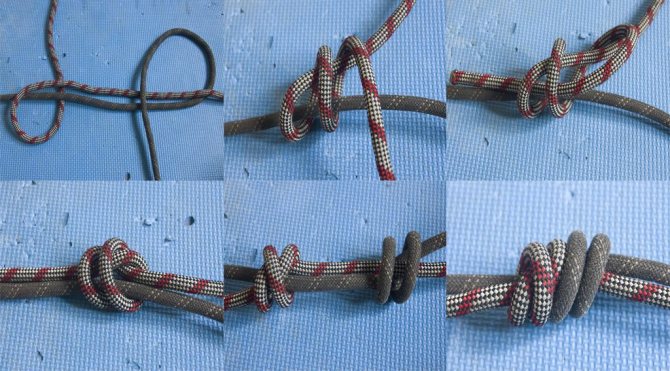
A very strong and reliable knot, used for tying ropes of both the same and different diameters. Plus, grapevine is quite beautiful. It is used simply everywhere, on ships and on land, in the mountains, in everyday life, in general, wherever you are lazy. It is knitted relatively simply: first, a double loop is tied on one rope, then the same one is tied on the second and tightened. This knot is similar to a weaving knot, but not one, but two turns of the rope are made.
Pros: a very powerful and reliable knot, does not require additional “controls”, you can tie ropes of different diameters. Cons: takes a lot of time.
It is with this knot that I recommend tying the cord for grasping knots such as Prusik, Marchard, Bachman, etc. It can be successfully used as a control knot. To do this, only one double loop is knitted on one rope; such a “control” will be more reliable than a regular one.
All nodes (Part 2)
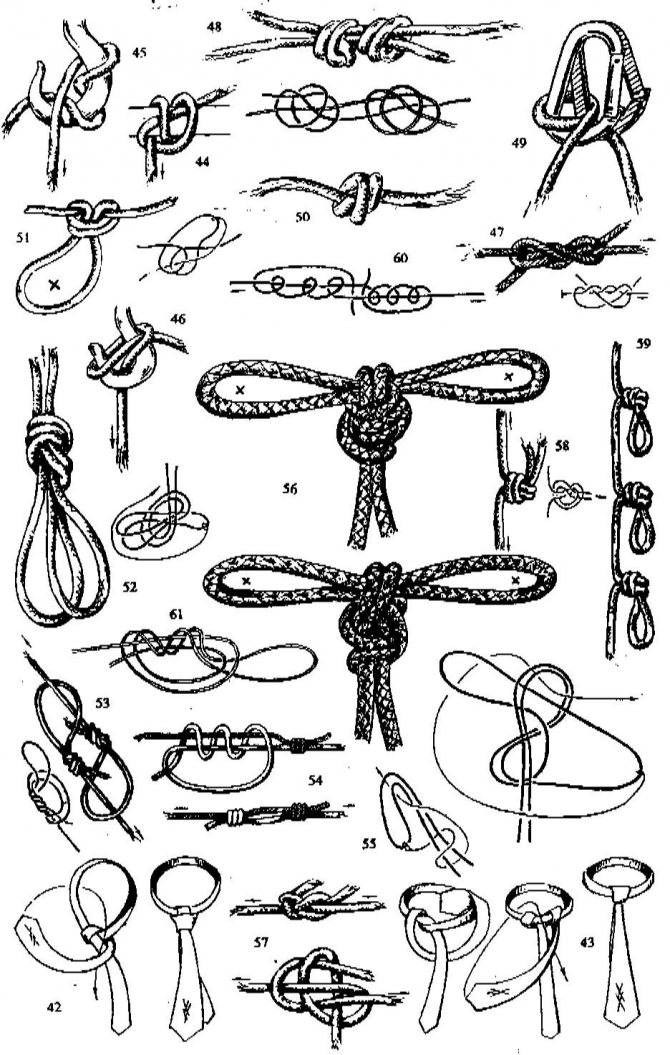
Millions of men use it every day. 43. Big tie knot - a large knot with a tightening loop for tying a tie.
44. Gaff - a knot is used to attach a rope to a cylindrical object.
45. A hook with a slag is a sea knot. Used for lifting loads with a crane or hook.
46. Tackle - sea knot. Used for attaching a cable to the hook.
47. Goldobin - a knot used for connecting two cables of the same thickness.
48. Grapevine (double weaving) is the most reliable knot for tying ropes of the same diameter, ribbons, knitting guy loops, and bookmark loops. This knot is especially convenient when tying a loop for self-belaying. The same knot can be used to adjust the length of the loop.
49. Guard (garda loop) - auxiliary, support unit. Performed using two climbing carabiners. An excellent tool for insurance. Practically irreplaceable when transporting a victim. Easy to knit. Reliable on wet and clay ropes.
50. Double simple - locking knot.
51. Double-headed bloodworm - a knot that forms a fixed loop in the middle of the rope. A type of alpine guide. Very reliable. It is used as an intermediate support point on traverses, railings, and carrying around obstacles (waterfalls) on plumbs. Dangerous mistakes: too loose, too tight, big loop.
52. Double conductor (rabbit ears) - a knot that forms a double fixed loop. Used for hanging simultaneously by two independent supports (bolt hooks). The unit allows adjustment and adjustment of the size of the loops until a uniform load is achieved on both supports.
53. Double loop - fisherman's knot. Used to splice two cords with loops. The latter are formed by surgical nodes according to the principle of an oak loop.
54. Double stevedoring (stevedoring tie) - a knot is used for splicing fishing gear. Knitted from two stevedoring knots according to the grapevine principle.
55. Nine - a knot that forms a fixed loop at the end of a rope. Used for fastening with a carabiner. *1968
56. Diametric conductor - serves to form two fixed loops in diametrically opposite directions from the direction of the root end of the rope.
57. Docker - auxiliary node. Used to tie together cables of different diameters.
58. Oak - a knot applicable only in exceptional cases for connecting two cables. The only positive quality is the speed of tying and relative reliability. Significantly weakens the strength of the rope. Not suitable for tying synthetic ropes and fishing lines.
59. Oak ladder - simple knitting of a series of oak knots. It is used in exceptional cases for descent or ascent on small plumbs. A prerequisite is to securely fasten the running end in the lower position after successively passing through oak loops. The only positive feature is the speed of tying and relative reliability. After use, it is extremely difficult to untie. Further use of the used rope as a working rope is prohibited due to its weakening.
60. Vein - an auxiliary knot that serves for reliable tying on nylon and other fishing lines. Known since the 19th century.
61. Vein loop - a knot that forms a fixed loop at the end of the thread. Suitable for thin fishing lines.
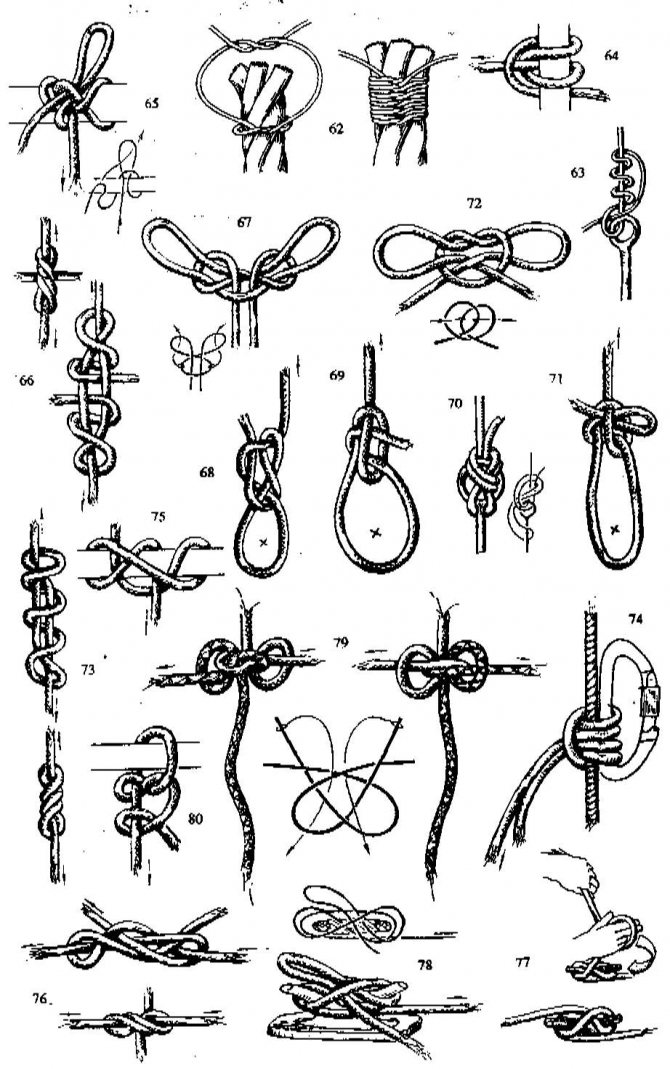
62. Western brand is one of the reliable ways to fasten the end of a cable with a synthetic thread.
63. The gripping knot is a half variation of the snake knot. Used for tying two synthetic cables. It is suitable for any fishing line and is a reliable knot.
64. Zigzag - auxiliary knot. Mainly used for securing and pulling high stacks of cargo in an open truck bed equipped with high racks.
65. Villainous - a knot that has been known for a long time, in different parts and under different names. Can be tied with a double folded rope. The best among similar robber and pirate nodes.
66. Snake - used to tie two cables made of any materials.
67. Spanish (boatswain) - an auxiliary knot that forms two loops. Used as a gazebo. It should be taken into account that small loops when tightening the main ends can be pulled through the knot and break its symmetry. Therefore, the Spanish-arbor knot should always be treated with caution.
68. A capstan loop is a knot that has two qualities. During the main knitting, it forms a tightening loop. But with further formation, a strong jerk on the running end and the side opposite to the latter, the loop changes its characteristics and turns into a fixed loop.
69. Cossack - a type of Kalmyk knot. Reliable self-tightening knot.
70. Californian - the knot was invented in the early seventies of the 20th century by amateur fishermen in California for tying hooks, swivels and sinkers to nylon fishing line.
71. Kalmyk - a practical and reliable self-tightening, resettable knot. It does not appear in any of the many manuals on knot tying published abroad. It is used to attach reins to a bridle, as well as for tying horses in the stable. It is used in the practice of the Russian fleet. The Kalmyk knot is quick and easy to knit and can be untied instantly.
72. Shackle (double top) - a knot that forms two loops. Its name in English means "handcuffs". The node can serve the same purpose.
73. Capuchin (“bloody knot”, stopper pigtail) - stopper knot. Used for fastening in narrow holes when mounted without a carabiner using bolt hooks). Used in emergency situations. The knot is quite reliable and easy to untie. The number of knots in a knot can be increased to nine; such knots were used by the Incas as knot writing (khipu). In the Middle Ages, they were tied by Capuchin monks at the ends of the cords that were used to girdle their cassocks. During the sailing fleet and until 1944, the British Army tied rope whips (cats) at the ends of their braids, intended for punishment. Often used as a decorative knot. Used in the macrome weaving technique.
74. Carbine knot - a combination of a gripping knot with a carabiner. When the load is removed, it moves more easily along the rope than the Bachmann knot. Works well on wet and icy ropes. In the event of a fall, the carabiner assembly delays the movement of the carabiner and protects it from falling. Knitted on double and single ropes.
75. Swing - self-tightening reliable knot. Doesn't unravel with multiple pulls. The strength of the rope is reduced slightly.
76. Dagger - one of the best knots for tying two large diameter plant cables. It is not difficult to untie if you loosen one of the outer loops.
77. Bollard - sea knot. Used for laying the cable on the bollard.
78. Bollard knot with a loop - a quick-release sea knot. Used for laying the cable on the bollard.
79. Cobra is a non-tightening knot. Used to splice two cables of the same diameter. Easily unties when removing the load. Springs under variable loads.
80. The bunk bayonet is a non-tightening knot. Holds securely and is easy to untie. Used in the navy for attaching hanging bunks.
Median conductor
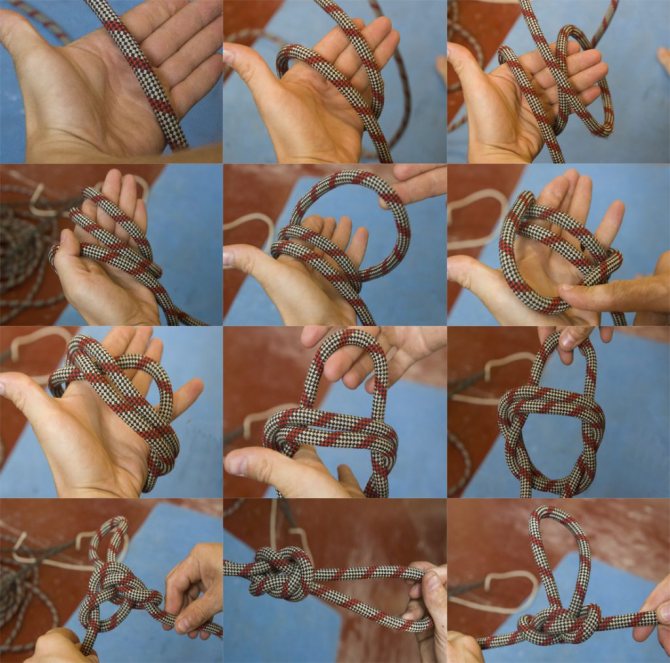
In marine terminology, this knot is called a “driving loop”. Outwardly, it resembles a burlat loop, but is more reliable and practical. The middle conductor is used wherever a strong and reliable loop in the middle of the rope is needed, for example, in mountaineering to organize ligaments. It can also be used to pass wiring along a stretched rope.
Pros: reliable and convenient, tied in the middle of the rope, does not “creep”. Disadvantages: the relative difficulty of tying, can be very, although not tightly, delayed.
I strongly recommend learning the median conductor as it is a relatively unique unit in its characteristics and has many possible applications.
There is a third part of articles about knots!
